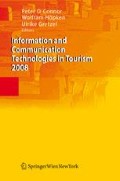Abstract
The rapid advancements in Information and Communication Technologies (ICTs) that have taken place over the last 20 years have had a tremendous impact on the travel and tourism industry. The wireless revolution experienced in the marketplace is predicted to further revolutionise the industry. This study examines the possible influence of new wireless technologies, such as WiMAX, and their implications for location-based services, on tourist destinations. WiMAX stands for Worldwide Interoperability for Microwave Access and offers long range wireless Internet connectivity. From the undertaken survey, it emerges that tourism and technology firms perceive WiMAX as a great tool for promotion and information provision. They estimate that WiMAX will support location-based applications and will offer effective mechanisms for communicating with travellers. Technical factors such as standards, user-friendliness of the system, and the quality of information provided to customers, are perceived to be the main success factors for the implementation and delivery of these applications.
Preview
Unable to display preview. Download preview PDF.
References
Alcatel (2005). Alcatel location-based services solution: a key fixed/mobile convergence enabler. White paper, available online at http://wwwl.alcatellucent.com/com/en/appcontent/apl/S0905-LBS-EN_tcml72-352261635.pdf [accessed 09/06/2007]
Alfaro, I., Nardon, M., Pianesi, F., Stock, O., and Zancanaro, M. (2005). Using cinematic techniques on mobile devices for cultural tourism. Information Technology & Tourism, 7(2): 61–71.
Bannister, J., Mather, P. and Coope, S. (2004). Convergence technologies for 3G networks: IP, UMTS, EGPRS and ATM. Chichester: Wiley, 1–9.
Bryson, J.M., and Crosby, B.C. (1992). Leadership for the common good: tackling public problems in a shared-power world. San Francisco: Jossey-Bass.
Buhalis, D. (1997). Information technology as a strategic tool for economic, social, cultural and environmental benefits enhancement of tourism at destination regions. Progress in Tourism and Hospitality Research, 3(1): 71–93.
Buhalis, D. (2003). E-tourism: information technology for strategic tourism management. Harlow: Financial Times Prentice Hall.
Buhalis, D., and Costa, C. (2006). Tourism management dynamics: trends, management, and tools. Amsterdam: Elsevier Butterworth-Heinemann.
Buhalis, D., and Flouri, E. (2004). Wireless technologies for tourism destinations. In A.J. Frew (2004), Information and Communication Technologies in Tourism 2004 Wien: Springer-Verlag, pp. 27–38.
E-Business Watch (2006). Sector Report No. 8: ICT and e-business in the tourism industry: ICT adoption and E-business activity in 2006. Salzburg/Brussels, available at http://www.ebusiness-watch.org/resources/tourism/SR08-2006_Tourism.pdf [accessed 01/03/2007]
Edwards, S.J., Blythe, P.T., Scott, S., and Weihong-Guo, A. (2006). Tourist information delivered through mobile devices: findings from the Image project. Information Technology and Tourism, 8(1): 31–46.
Hawking, P., Stein, A., Zeleznikow, J., Sharma, P., Nugent, D., Dawson, L., and Foster, S. (2005).Emerging issues in Location Based Systems. Proceedings of the International Conference on Mobile Business (ICMB’05). Washington, DC, USA: IEEE Computer Society, 75–81.
Howell, D.W. (1993). An introduction to the travel and tourism industry. South Western Publishing Co.
Krug, K., Abderhalden, W., and Haller, R. (2003). User needs for location-based services in protected areas: case study Swiss National Park. Information Technology & Tourism, 5(4): 235–242.
Kuran, M.S., and Tugcu, T. (2007). A survey on emerging broadband wireless technologies, Computer Networks, 51(11): 3013–3046.
Laudon, A K.C., and Laudon, J.P. (2006). Management information systems: managing the digital firm (10th ed.). Upper Saddle River, NJ: Prentice Hall.
Minoli, D. (2003). Hotspot networks: Wi-Fi for public access locations. New York: McGraw-Hill.
Odinma, A.C., Oborkhale, L.I„ Kah, M.M.O. (2007). The trends in broadband wireless network technologies. The Pacific Journal of Science and Technology, 8(1), 118–125.
Ohrtman, F. (2005). WiMAX handbook: building 802.16 wireless networks. New York: McGraw-Hill.
Patton, M.Q. (2002). Qualitative research and evaluation methods (3rd ed.). London: Sage.
Salkintzis, A.K., and Passas, N. (2005). Emerging wireless multimedia services and technologies. Chichester: John Wiley.
Schmidt-Belz, B., Laamanen, H., Poslad, S., and Zipf, A. (2003). Location-based mobile tourist services: first user experiences. In A.J. Frew, M. Hitz and P. O’ Connor (Eds.), Information and communication technologies in tourism 2003, proceedings of the international conference in Helsinki, Finland, 2003, Wien: Springer-Verlag, pp. 115–123.
Techworld (10/05/2007). Mobile WiMAX may be 4G, but can it replace cellular? Online article, Available at http://www.techworld.com/mobility/features/ index.cfm?featureid=3363 [accessed 18/07/2007]
Umlauft, M., Pospischil, G., Nikifeld, G., and Michlmayr, E. (2003). LOL@, a mobile tourist guide for UMTS, Information Technology & Tourism, 5(3): 151–164.
WiMAX Forum (2004). Regulatory Position and Goals of the WiMAX Forum. White paper available online at htlp://www.wimaxforum.org/technology/downloads/ WiMAX_Forum_Regulatory_Whitepaper_v08092004.pdf [accessed 10/06/2007]
Author information
Authors and Affiliations
Editor information
Editors and Affiliations
Rights and permissions
Copyright information
© 2008 Springer-Verlag Wien
About this paper
Cite this paper
Buhalis, D., Pistidda, L. (2008). The Impact of WiMAX on Tourist Destinations. In: O’Connor, P., Höpken, W., Gretzel, U. (eds) Information and Communication Technologies in Tourism 2008. Springer, Vienna. https://doi.org/10.1007/978-3-211-77280-5_34
Download citation
DOI: https://doi.org/10.1007/978-3-211-77280-5_34
Publisher Name: Springer, Vienna
Print ISBN: 978-3-211-77279-9
Online ISBN: 978-3-211-77280-5

